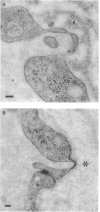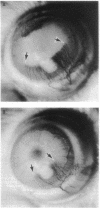Abstract
Thalidomide is a potent teratogen causing dysmelia (stunted limb growth) in humans. We have demonstrated that orally administered thalidomide is an inhibitor of angiogenesis induced by basic fibroblast growth factor in a rabbit cornea micropocket assay. Experiments including the analysis of thalidomide analogs revealed that the antiangiogenic activity correlated with the teratogenicity but not with the sedative or the mild immunosuppressive properties of thalidomide. Electron microscopic examination of the corneal neovascularization of thalidomide-treated rabbits revealed specific ultrastructural changes similar to those seen in the deformed limb bud vasculature of thalidomide-treated embryos. These experiments shed light on the mechanism of thalidomide's teratogenicity and hold promise for the potential use of thalidomide as an orally administered drug for the treatment of many diverse diseases dependent on angiogenesis.
Full text
PDF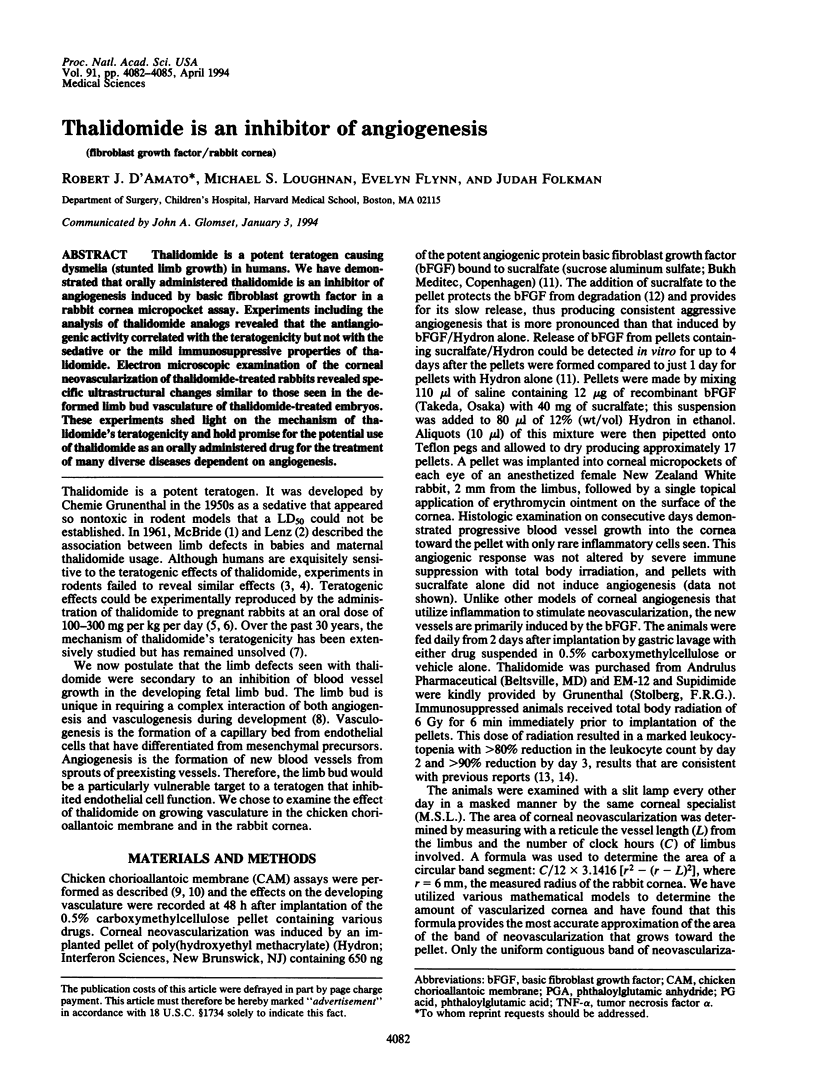
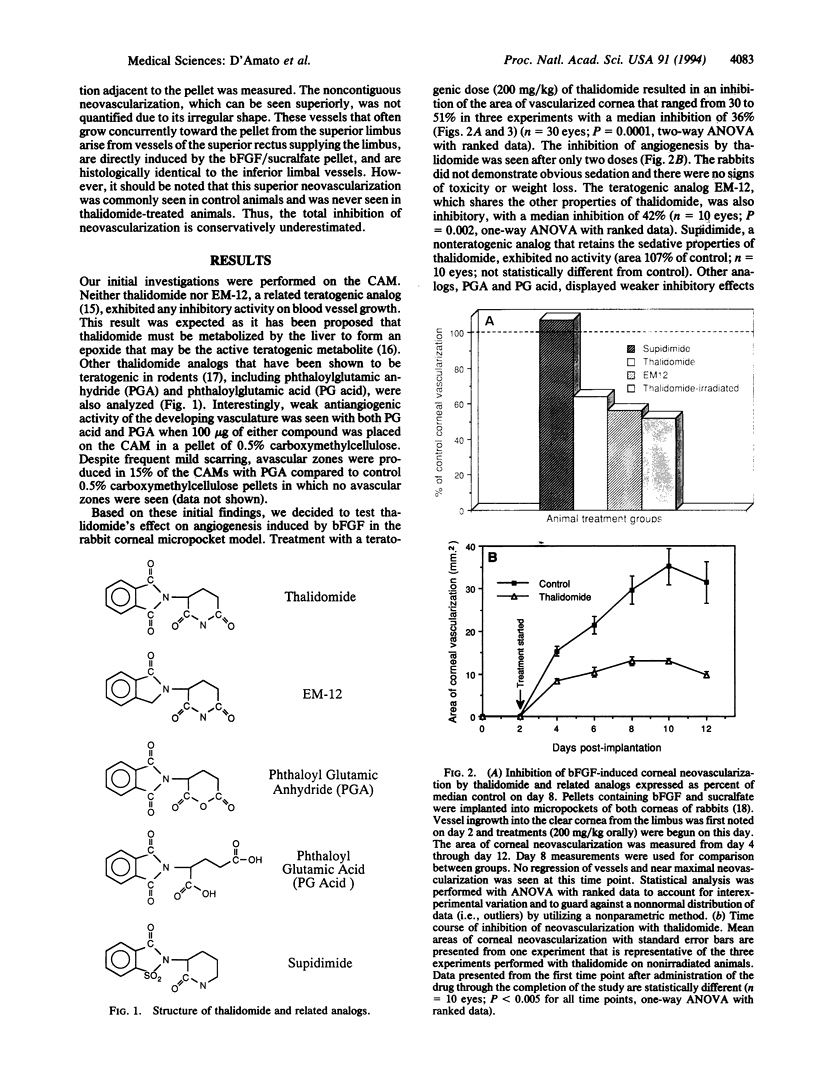
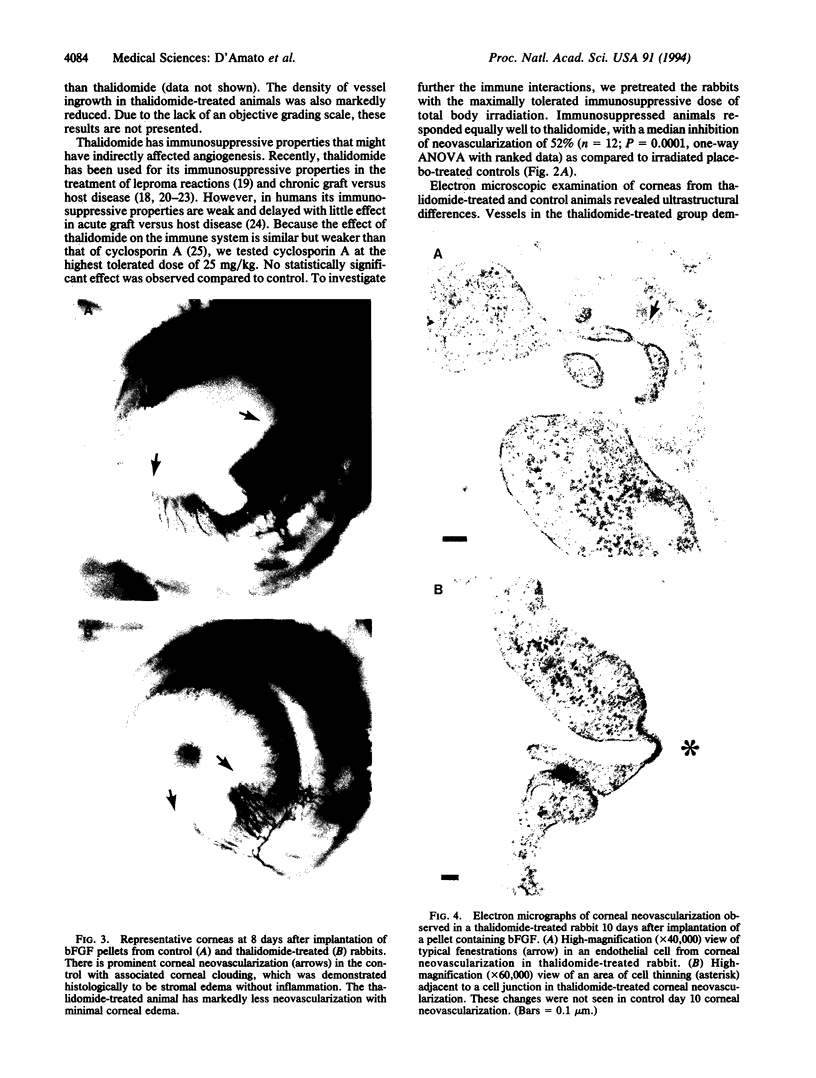
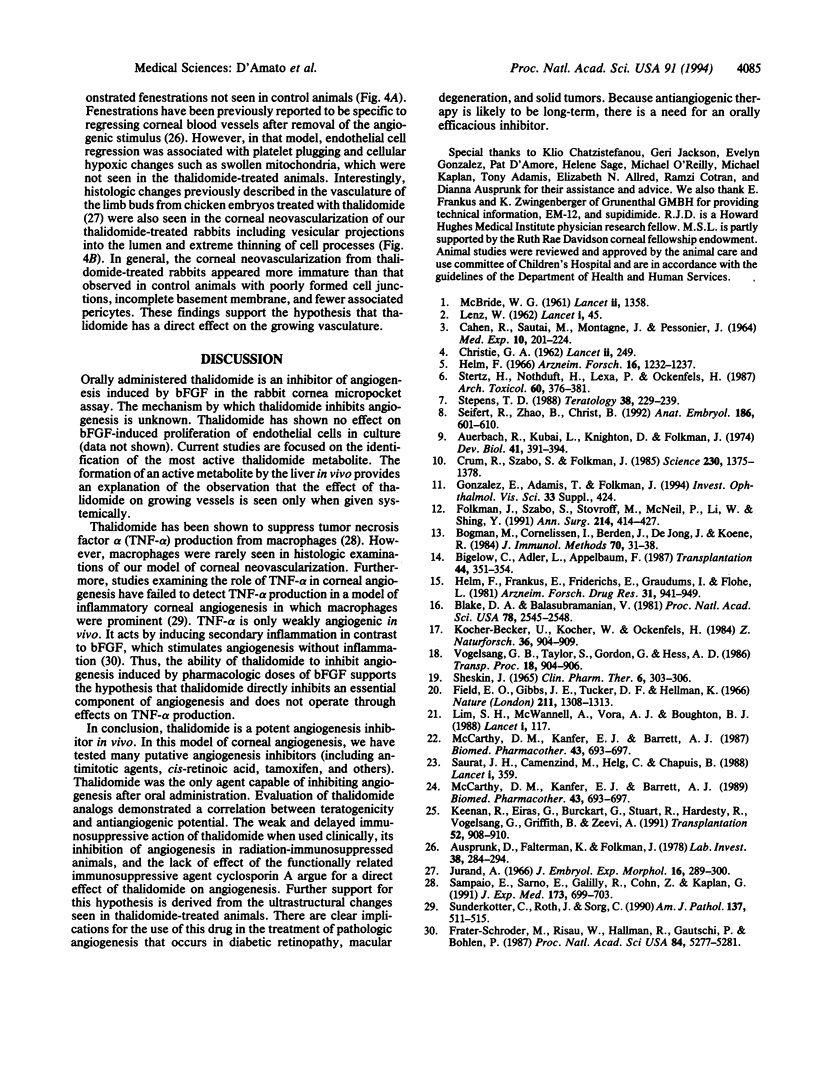
Images in this article
Selected References
These references are in PubMed. This may not be the complete list of references from this article.
- Auerbach R., Kubai L., Knighton D., Folkman J. A simple procedure for the long-term cultivation of chicken embryos. Dev Biol. 1974 Dec;41(2):391–394. doi: 10.1016/0012-1606(74)90316-9. [DOI] [PubMed] [Google Scholar]
- Ausprunk D. H., Falterman K., Folkman J. The sequence of events in the regression of corneal capillaries. Lab Invest. 1978 Mar;38(3):284–294. [PubMed] [Google Scholar]
- Bigelow C. L., Adler L. T., Appelbaum F. R. Allogeneic bone marrow transplantation in irradiated adult rabbits. Transplantation. 1987 Sep;44(3):351–354. doi: 10.1097/00007890-198709000-00005. [DOI] [PubMed] [Google Scholar]
- Bogman M. J., Cornelissen I. M., Berden J. H., De Jong J., Koene R. A. A comparative study of total body irradiation as a method of inducing granulocyte depletion in mice. J Immunol Methods. 1984 May 11;70(1):31–38. doi: 10.1016/0022-1759(84)90386-7. [DOI] [PubMed] [Google Scholar]
- CAHEN R., SAUTAI M., MONTAGNE J. RECHERCHE DE L'EFFET T'ERATOG'ENE DE LA 2-DI'ETHYLAMINOPROPIOPH'ENONE. Med Exp Int J Exp Med. 1964;10:201–224. [PubMed] [Google Scholar]
- Crum R., Szabo S., Folkman J. A new class of steroids inhibits angiogenesis in the presence of heparin or a heparin fragment. Science. 1985 Dec 20;230(4732):1375–1378. doi: 10.1126/science.2416056. [DOI] [PubMed] [Google Scholar]
- Field E. O., Gibbs J. E., Tucker D. F., Hellmann K. Effect of thalidomide on the graft versus host reaction. Nature. 1966 Sep 17;211(5055):1308–1310. doi: 10.1038/2111308a0. [DOI] [PubMed] [Google Scholar]
- Folkman J., Szabo S., Stovroff M., McNeil P., Li W., Shing Y. Duodenal ulcer. Discovery of a new mechanism and development of angiogenic therapy that accelerates healing. Ann Surg. 1991 Oct;214(4):414–427. doi: 10.1097/00000658-199110000-00006. [DOI] [PMC free article] [PubMed] [Google Scholar]
- Fràter-Schröder M., Risau W., Hallmann R., Gautschi P., Böhlen P. Tumor necrosis factor type alpha, a potent inhibitor of endothelial cell growth in vitro, is angiogenic in vivo. Proc Natl Acad Sci U S A. 1987 Aug;84(15):5277–5281. doi: 10.1073/pnas.84.15.5277. [DOI] [PMC free article] [PubMed] [Google Scholar]
- Gordon G. B., Spielberg S. P., Blake D. A., Balasubramanian V. Thalidomide teratogenesis: evidence for a toxic arene oxide metabolite. Proc Natl Acad Sci U S A. 1981 Apr;78(4):2545–2548. doi: 10.1073/pnas.78.4.2545. [DOI] [PMC free article] [PubMed] [Google Scholar]
- Helm F. C., Frankus E., Friderichs E., Graudums I., Flohé L. Comparative teratological investigation of compounds structurally and pharmacologically related to thalidomide. Arzneimittelforschung. 1981;31(6):941–949. [PubMed] [Google Scholar]
- Helm F. Tierexperimentelle Untersuchungen und Dysmeliesyndrom. Arzneimittelforschung. 1966 Sep;16(9):1232–1244. [PubMed] [Google Scholar]
- Jurand A. Early changes in limb buds of chick embryos after thalidomide treatment. J Embryol Exp Morphol. 1966 Oct;16(2):289–300. [PubMed] [Google Scholar]
- Keenan R. J., Eiras G., Burckart G. J., Stuart R. S., Hardesty R. L., Vogelsang G., Griffith B. P., Zeevi A. Immunosuppressive properties of thalidomide. Inhibition of in vitro lymphocyte proliferation alone and in combination with cyclosporine or FK506. Transplantation. 1991 Nov;52(5):908–910. [PubMed] [Google Scholar]
- Kocher-Becker U., Kocher W., Ockenfels H. Thalidomide-like malformations caused by Tween surfactant in mice. Z Naturforsch C. 1981 Sep-Oct;36(9-10):904–906. [PubMed] [Google Scholar]
- Lim S. H., McWhannell A., Vora A. J., Boughton B. J. Successful treatment with thalidomide of acute graft-versus-host disease after bone-marrow transplantation. Lancet. 1988 Jan 16;1(8577):117–117. doi: 10.1016/s0140-6736(88)90312-1. [DOI] [PubMed] [Google Scholar]
- McCarthy D. M., Kanfer E. J., Barrett A. J. Thalidomide for the therapy of graft-versus-host disease following allogeneic bone marrow transplantation. Biomed Pharmacother. 1989;43(9):693–697. doi: 10.1016/0753-3322(89)90089-9. [DOI] [PubMed] [Google Scholar]
- McCarthy D. M., Kanfer E. J., Barrett A. J. Thalidomide for the therapy of graft-versus-host disease following allogeneic bone marrow transplantation. Biomed Pharmacother. 1989;43(9):693–697. doi: 10.1016/0753-3322(89)90089-9. [DOI] [PubMed] [Google Scholar]
- SHESKIN J. THALIDOMIDE IN THE TREATMENT OF LEPRA REACTIONS. Clin Pharmacol Ther. 1965 May-Jun;6:303–306. doi: 10.1002/cpt196563303. [DOI] [PubMed] [Google Scholar]
- Sampaio E. P., Sarno E. N., Galilly R., Cohn Z. A., Kaplan G. Thalidomide selectively inhibits tumor necrosis factor alpha production by stimulated human monocytes. J Exp Med. 1991 Mar 1;173(3):699–703. doi: 10.1084/jem.173.3.699. [DOI] [PMC free article] [PubMed] [Google Scholar]
- Saurat J. H., Camenzind M., Helg C., Chapuis B. Thalidomide for graft-versus-host disease after bone marrow transplantation. Lancet. 1988 Feb 13;1(8581):359–359. doi: 10.1016/s0140-6736(88)91151-8. [DOI] [PubMed] [Google Scholar]
- Seifert R., Zhao B., Christ B. Cytokinetic studies on the aortic endothelium and limb bud vascularization in avian embryos. Anat Embryol (Berl) 1992 Dec;186(6):601–610. doi: 10.1007/BF00186983. [DOI] [PubMed] [Google Scholar]
- Stephens T. D. Proposed mechanisms of action in thalidomide embryopathy. Teratology. 1988 Sep;38(3):229–239. doi: 10.1002/tera.1420380307. [DOI] [PubMed] [Google Scholar]
- Sterz H., Nothdurft H., Lexa P., Ockenfels H. Teratologic studies on the Himalayan rabbit: new aspects of thalidomide-induced teratogenesis. Arch Toxicol. 1987 Jul;60(5):376–381. doi: 10.1007/BF00295758. [DOI] [PubMed] [Google Scholar]
- Sunderkötter C., Roth J., Sorg C. Immunohistochemical detection of bFGF and TNF-alpha in the course of inflammatory angiogenesis in the mouse cornea. Am J Pathol. 1990 Sep;137(3):511–515. [PMC free article] [PubMed] [Google Scholar]




